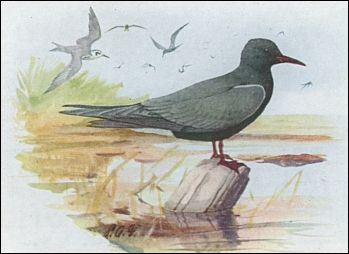

Have you heard about the Eskimo boy who passed time by throwing pebbles at seabirds? It seems that he left no tern unstoned. Or of one bird telling another bird that one good tern deserves another? For those of you not in on the joke, terns, spelled t-e-r-n-s, are birds closely related to sea gulls and, like gulls, most associate predominately with oceanic waters. But that still leaves a lot of leeway, and various kinds of terns, off and on manage to appear in our desert.
Three species seem to be uncommon wanderers temporarily stopping off in waterways along the Rio Grande and Pecos River. The wildlife refuge at Bosque del Apache, with its permanent large bodies of water, seems to be a favorite. A fourth species, the Black Tern, is common in the interior of North America and occurs throughout our region where there are rivers and ponds, and several hundred at a time have been observed at the Bosque.
Do you suppose that these water birds, coming into our desert, are
saying that ternabout is fair play?

Contributor: Arthur H. Harris, Laboratory for Environmental Biology, Centennial Museum, University of Texas at El Paso.
Desert Diary is a joint production of the Centennial Museum and KTEP National Public Radio at the University of Texas at El Paso.

Painting of a Black Tern by Louis Agassiz Fuertes (Henshaw, 1921).
Henshaw, H. W. 1921. The book of birds. Common birds of town and country and American game birds. National Geographic Society, Washington, D.C. 195 pp.
Ligon, J. S. 1961. New Mexico birds and where to find them. University of New Mexico Press, Albuquerque. 360 pp.
Terns, Biotic Information System of New Mexico.